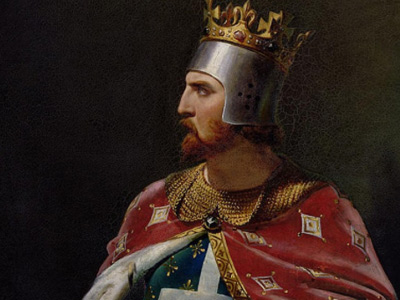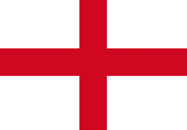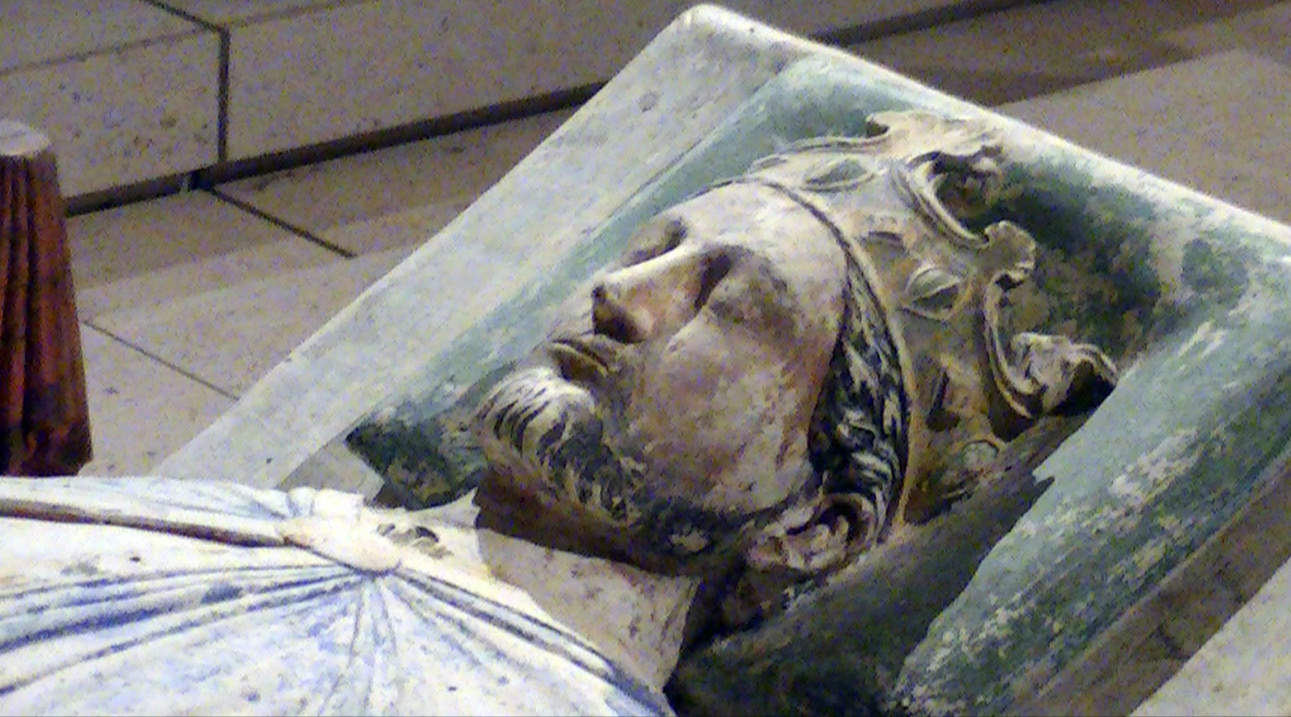Richard I of England (1157-1199)
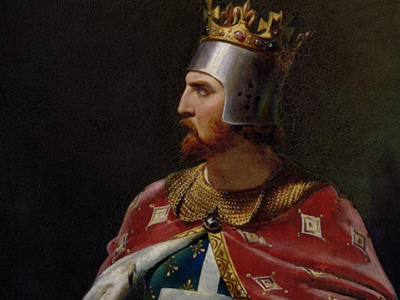
Later Years and Death
In Richard's absence, his brother John revolted with the aid of Philip; amongst Philip's conquests in the period of Richard's imprisonment was Normandy. Richard forgave John when they met again and named him as his heir in place of their nephew, Arthur.
Richard began his reconquest of Normandy. The fall of the Château de Gisors to the French in 1196 opened a gap in the Norman defences. The search began for a fresh site for a new castle to defend the duchy of Normandy and act as a base from which Richard could launch his campaign to take back the Vexin from French control. A naturally defensible position was identified perched high above the River Seine, an important transport route, in the manor of Andeli. Under the terms of the Treaty of Louviers (December 1195) between Richard and Philip II, neither king was allowed to fortify the site; despite this, Richard intended to build the vast Château Gaillard. Richard tried to obtain the manor through negotiation. Walter de Coutances, Archbishop of Rouen, was reluctant to sell the manor as it was one of the diocese's most profitable, and other lands belonging to the diocese had recently been damaged by war. When Philip besieged Aumale in Normandy, Richard grew tired of waiting and seized the manor, although the act was opposed by the Church. The archbishop issued an interdict against performing church services in the duchy of Normandy; Roger of Howden detailed "unburied bodies of the dead lying in the streets and square of the cities of Normandy". The interdict was still in force when work began on the castle, but Pope Celestine III repealed it in April 1197 after Richard made gifts of land to the archibishop and the diocese of Rouen, including two manors and the prosperous port of Dieppe.
Royal expenditure on castles declined from the levels spent under Henry II, attributed to a concentration of resources on Richard's war with the king of France The Kingdom of France is the historiographical name or umbrella term given to various political entities of France in the medieval and early modern period. It was one of the most powerful states in Europe since the High Middle Ages. It was also an early colonial power, with possessions around the world. Colonial conflicts with Great Britain led to the loss of much of its North American holdings by 1763. The Kingdom of France adopted a written constitution in 1791, but the Kingdom was abolished a year later and replaced with the First French Republic.. However, the work at Château Gaillard was some of the most expensive of its time and cost an estimated £15,000 to £20,000 between 1196 and 1198. This was more than double Richard's spending on castles in England
The Kingdom of France is the historiographical name or umbrella term given to various political entities of France in the medieval and early modern period. It was one of the most powerful states in Europe since the High Middle Ages. It was also an early colonial power, with possessions around the world. Colonial conflicts with Great Britain led to the loss of much of its North American holdings by 1763. The Kingdom of France adopted a written constitution in 1791, but the Kingdom was abolished a year later and replaced with the First French Republic.. However, the work at Château Gaillard was some of the most expensive of its time and cost an estimated £15,000 to £20,000 between 1196 and 1198. This was more than double Richard's spending on castles in England The Kingdom of England was a sovereign state on the island of Great Britain from about 927, when it emerged from various Anglo-Saxon kingdoms, until 1 May 1707, when it united with Scotland to form the Kingdom of Great Britain. The Viking invasions of the 9th century upset the balance of power between the English kingdoms, and native Anglo-Saxon life in general. The English lands were unified in the 10th century in a reconquest completed by King Æthelstan in 927., an estimated £7,000. Unprecedented in its speed of construction, the castle was mostly complete in two years, when most construction on such a scale would have taken the best part of a decade. According to William of Newburgh, in May 1198 Richard and the labourers working on the castle were drenched in a "rain of blood". While some of his advisers thought the rain was an evil omen, Richard was undeterred. As no master-mason is mentioned in the otherwise detailed records of the castle's construction, military historian Allen Brown has suggested that Richard himself was the overall architect; this is supported by the interest Richard showed in the work through his frequent presence. In his final years, the castle became Richard's favourite residence, and writs and charters were written at Château Gaillard bearing "apud Bellum Castrum de Rupe" (at the Fair Castle of the Rock).
The Kingdom of England was a sovereign state on the island of Great Britain from about 927, when it emerged from various Anglo-Saxon kingdoms, until 1 May 1707, when it united with Scotland to form the Kingdom of Great Britain. The Viking invasions of the 9th century upset the balance of power between the English kingdoms, and native Anglo-Saxon life in general. The English lands were unified in the 10th century in a reconquest completed by King Æthelstan in 927., an estimated £7,000. Unprecedented in its speed of construction, the castle was mostly complete in two years, when most construction on such a scale would have taken the best part of a decade. According to William of Newburgh, in May 1198 Richard and the labourers working on the castle were drenched in a "rain of blood". While some of his advisers thought the rain was an evil omen, Richard was undeterred. As no master-mason is mentioned in the otherwise detailed records of the castle's construction, military historian Allen Brown has suggested that Richard himself was the overall architect; this is supported by the interest Richard showed in the work through his frequent presence. In his final years, the castle became Richard's favourite residence, and writs and charters were written at Château Gaillard bearing "apud Bellum Castrum de Rupe" (at the Fair Castle of the Rock).
Château Gaillard was ahead of its time, featuring innovations that would be adopted in castle architecture nearly a century later. Allen Brown described Château Gaillard as "one of the finest castles in Europe", and military historian Sir Charles Oman wrote that it was considered "the masterpiece of its time. The reputation of its builder, Cœur de Lion, as a great military engineer might stand firm on this single structure. He was no mere copyist of the models he had seen in the East, but introduced many original details of his own invention into the stronghold".
Determined to resist Philip's designs on contested Angevin lands such as the Vexin and Berry, Richard poured all his military expertise and vast resources into war on the French King. He organized an alliance against Philip, including Baldwin IX of Flanders, Renaud, Count of Boulogne, and his father-in-law King Sancho VI of Navarre, who raided Philip's lands from the south. Most importantly, he managed to secure the Welf inheritance in Saxony for his nephew, Henry the Lion's son Otto of Poitou, who was elected Otto IV of Germany in 1198.
Partly as a result of these and other intrigues, Richard won several victories over Philip. At Fréteval in 1194, just after Richard's return to France from captivity and money-raising in England, Philip fled, leaving his entire archive of financial audits and documents to be captured by Richard. At the Battle of Gisors (sometimes called Courcelles) in 1198, Richard took Dieu et mon Droit—"God and my Right"—as his motto (still used by the British The United Kingdom of Great Britain and Northern Ireland, commonly known as the United Kingdom (UK) or Britain, is a country in Europe, off the north-western coast of the continental mainland. It comprises England, Scotland, Wales and Northern Ireland. The UK became the world's first industrialised country and was the world's foremost power during the 19th and early 20th centuries. monarchy today), echoing his earlier boast to the Emperor Henry that his rank acknowledged no superior but God.
The United Kingdom of Great Britain and Northern Ireland, commonly known as the United Kingdom (UK) or Britain, is a country in Europe, off the north-western coast of the continental mainland. It comprises England, Scotland, Wales and Northern Ireland. The UK became the world's first industrialised country and was the world's foremost power during the 19th and early 20th centuries. monarchy today), echoing his earlier boast to the Emperor Henry that his rank acknowledged no superior but God.
In March 1199, Richard was in Limousin suppressing a revolt by Viscount Aimar V of Limoges. Although it was Lent, he "devastated the Viscount's land with fire and sword". He besieged the puny, virtually unarmed castle of Châlus-Chabrol. Some chroniclers claimed that this was because a local peasant had uncovered a treasure trove of Roman gold, which Richard claimed from Aimar in his position as feudal overlord.
In the early evening of 25 March 1199, Richard was walking around the castle perimeter without his chainmail, investigating the progress of sappers on the castle walls. Missiles were occasionally shot from the castle walls, but these were given little attention. One defender in particular amused the king greatly—a man standing on the walls, crossbow in one hand, the other clutching a frying pan he had been using all day as a shield to beat off missiles. He deliberately aimed at the king, which the king applauded; however, another crossbowman then struck the king in the left shoulder near the neck. He tried to pull this out in the privacy of his tent but failed; a surgeon, called a "butcher" by Howden, removed it, "carelessly mangling" the King's arm in the process.
The wound swiftly became gangrenous. Richard asked to have the crossbowman brought before him; called alternatively Pierre (or Peter) Basile, John Sabroz, Dudo, and Bertrand de Gourdon (from the town of Gourdon) by chroniclers, the man turned out (according to some sources, but not all) to be a boy. He said Richard had killed his father and two brothers, and that he had killed Richard in revenge. He expected to be executed, but as a final act of mercy Richard forgave him, saying "Live on, and by my bounty behold the light of day", before he ordered the boy to be freed and sent away with 100 shillings. It is unclear whether the King's pardon was upheld following his death. Richard then set his affairs in order, bequeathing all his territory to his brother John and his jewels to his nephew Otto.
Richard died on 6 April 1199 in the arms of his mother; it was later said that "As the day was closing, he ended his earthly day". Because of the nature of Richard's death, he was later referred to as "the Lion (that) by the Ant was slain". According to one chronicler, Richard's last act of chivalry proved fruitless when the infamous mercenary captain Mercadier had the crossbowman flayed alive and hanged as soon as Richard died.
Richard's heart was buried at Rouen in Normandy, his entrails in Châlus (where he died), and the rest of his body at the feet of his father at Fontevraud Abbey in Anjou. In 2012, scientists analysed the remains of Richard's heart and found that it had been embalmed with various substances, including frankincense, a symbolically important substance because it had been present both at the birth and embalming of the Christ.
Henry Sandford, Bishop of Rochester (1226–1235) announced that he had seen a vision of Richard ascending to Heaven in March 1232 (along with Stephen Langton, the former Archbishop of Canterbury), the king having presumably spent 33 years in purgatory as expiation for his sins.
Richard produced no legitimate heirs and acknowledged only one illegitimate son, Philip of Cognac. As a result, he was succeeded by his brother John as King of England. However, his French territories initially rejected John as a successor, preferring his nephew Arthur of Brittany, the son of their late brother Geoffrey, whose claim was by modern standards better than John's. The lack of any direct heirs from Richard was the first step in the dissolution of the Angevin Empire.
HISTORY
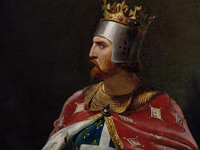
RESOURCES
This article uses material from the Wikipedia article "Richard I of England (1157-1199)", which is released under the Creative Commons Attribution-Share-Alike License 3.0.
© Stories Preschool. All Rights Reserved.
